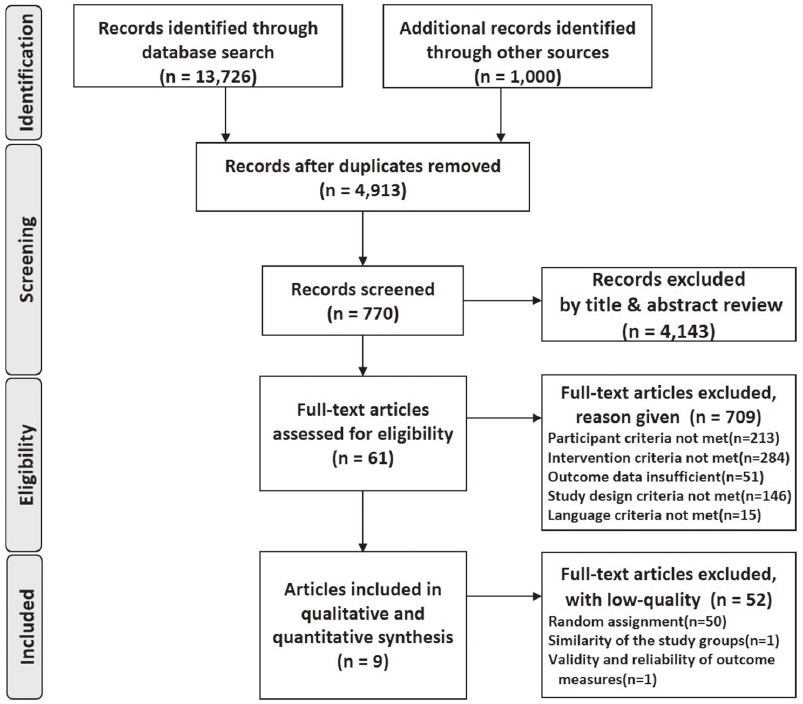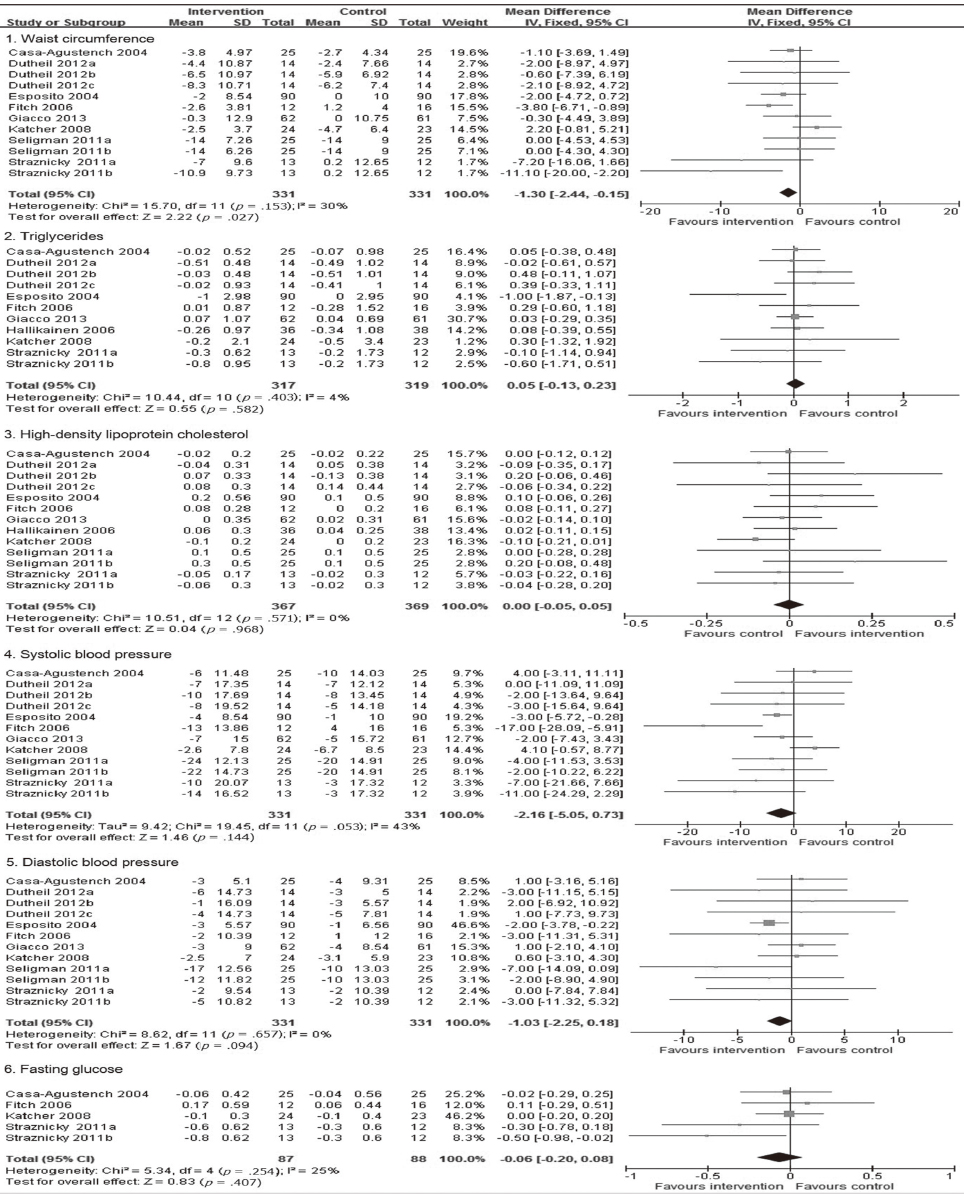J Korean Acad Nurs.
2015 Aug;45(4):483-494. 10.4040/jkan.2015.45.4.483.
Effects of Dietary and Physical Activity Interventions on Metabolic Syndrome: A Meta-analysis
- Affiliations
-
- 1Division of Nursing Science, Ewha Womans University, Seoul, Korea.
- 2Department of Nursing, Tongmyong University, Busan, Korea. yangsj@ewha.ac.kr
- KMID: 2164389
- DOI: http://doi.org/10.4040/jkan.2015.45.4.483
Abstract
- PURPOSE
This study identified effects of dietary and physical activity interventions including dietary interventions or physical activity interventions alone or combined dietary-physical activity interventions to improve symptoms in metabolic syndrome including abdominal obesity, high triglycerides, low high density lipoprotein cholesterol, elevated blood pressure, and elevated fasting glucose through meta-analysis.
METHODS
Articles on metabolic syndrome X published from 1988 to 2013 were searched through electronic databases, Google Scholar, and reference reviews. Methodological quality was assessed by the checklist, SIGN (Scottish Intercollegiate Guidelines Network).
RESULTS
In the meta-analysis, there were 9 articles reporting 13 interventions with 736 participants. Using random effect models, the dietary and/or physical activity interventions showed a lower mean difference in waist circumference ( - 1.30 cm, 95% CI: - 2.44~ - 0.15, p =.027). The combined dietary-physical activity interventions showed a lower mean difference in waist circumference ( - 2.77 cm, 95% CI: - 4.77~ - 0.76, p =.007) and systolic blood pressure ( - 5.44 mmHg, 95% CI: - 10.76~ - 0.12, p =.044). Additionally, interventions of over 24 weeks yielded a lower mean difference in waist circumference ( - 2.78 cm, 95% CI: - 4.69~ - 0.87, p =.004) and diastolic blood pressure ( - 1.93 mmHg, 95% CI: - 3.63~ - 0.22, p =.026).
CONCLUSION
The findings indicate that dietary and/or physical activity interventions for metabolic syndrome reduce central obesity with no adverse effects. This finding provides objective evidences for dietary and physical activity management on metabolic syndrome as an efficient intervention.
MeSH Terms
Figure
Cited by 2 articles
-
Effects of a Self-Care Reinforcement Program for Socially Vulnerable Elderly Women with Metabolic Syndrome in Korea
Mikyung Park, Kiwol Sung
J Korean Acad Community Health Nurs. 2019;30(3):271-280. doi: 10.12799/jkachn.2019.30.3.271.A Pilot Study of APN-led Self-management Program to Improve Cardiovascular Health Status among Korean Women with Risk Factors
Nah-Mee Shin, Nah-Mee Shin, Ji-Won Yoon, Jiwon Choi, Younghee Park, Songi Jeon
Korean J Adult Nurs. 2016;28(2):237-245. doi: 10.7469/kjan.2016.28.2.237.
Reference
-
1. National Cholesterol Education Program (NCEP) Expert Panel on Detection, Evaluation, and Treatment of High Blood Cholesterol in Adults (Adult Treatment Panel III). Third report of the national cholesterol education program (NCEP) Expert panel on detection, evaluation, and treatment of high blood cholesterol in adults (Adult Treatment Panel III) final report. Circulation. 2002; 106(25):3143–3421.2. International Diabetes Federation. The IDF consensus worldwide definition of the metabolic syndrome [Internet]. Brussels, BE: Author;2006. cited 2014 October 30. Available from: www.idf.org/webdata/docs/MetS_def_update2006.pdf.3. Alberti KG, Zimmet PZ. Definition, diagnosis and classification of diabetes mellitus and its complications. Part 1: Diagnosis and classification of diabetes mellitus provisional report of a WHO consultation. Diabet Med. 1998; 15(7):539–553. DOI: 10.1002/(sici)1096-9136(199807)15:7<539::aid-dia668>3.0.co;2-s.4. Grundy SM. Metabolic syndrome pandemic. Arterioscler Thromb Vasc Biol. 2008; 28(4):629–636. DOI: 10.1161/atvbaha.107.151092.5. Kim E, Oh SW. Gender differences in the association of occupation with metabolic syndrome in Korean adults. Korean J Obes. 2012; 21(2):108–114. DOI: 10.7570/kjo.2012.21.2.108.6. Gami AS, Witt BJ, Howard DE, Erwin PJ, Gami LA, Somers VK, et al. Metabolic syndrome and risk of incident cardiovascular events and death: A systematic review and meta-analysis of longitudinal studies. J Am Coll Cardiol. 2007; 49(4):403–414. DOI: 10.1016/j.jacc.2006.09.032.7. Kim MK, Park JH. Metabolic syndrome. J Korean Med Assoc. 2012; 55(10):1005–1013. DOI: 10.5124/jkma.2012.55.10.1005.8. Kelley DE, Wing R, Buonocore C, Sturis J, Polonsky K, Fitzsimmons M. Relative effects of calorie restriction and weight loss in noninsulin-dependent diabetes mellitus. J Clin Endocrinol Metab. 1993; 77(5):1287–1293. DOI: 10.1210/jcem.77.5.8077323.9. Pitsavos C, Panagiotakos D, Weinem M, Stefanadis C. Diet, exercise and the metabolic syndrome. Rev Diabet Stud. 2006; 3(3):118–126. DOI: 10.1900/rds.2006.3.118.10. Jenkins DJ, Kendall CW, Augustin LS, Franceschi S, Hamidi M, Marchie A, et al. Glycemic index: overview of implications in health and disease. Am J Clin Nutr. 2002; 76(1):266S–273S.11. Kastorini CM, Milionis HJ, Esposito K, Giugliano D, Goudevenos JA, Panagiotakos DB. The effect of mediterranean diet on metabolic syndrome and its components: A meta-analysis of 50 studies and 534,906 individuals. J Am Coll Cardiol. 2011; 57(11):1299–1313. DOI: 10.1016/j.jacc.2010.09.073.12. Blanco Mejia S, Kendall CW, Viguiliouk E, Augustin LS, Ha V, Cozma AI, et al. Effect of tree nuts on metabolic syndrome criteria: A systematic review and meta-analysis of randomised controlled trials. BMJ Open. 2014; 4(7):e004660. DOI: 10.1136/bmjopen-2013-004660.13. Jansen S, Lopez-Miranda J, Salas J, Castro P, Paniagua JA, Lopez-Segura F, et al. Plasma lipid response to hypolipidemic diets in young healthy non-obese men varies with body mass index. J Nutr. 1998; 128(7):1144–1149.14. Schwingshackl L, Dias S, Strasser B, Hoffmann G. Impact of different training modalities on anthropometric and metabolic characteristics in overweight/obese subjects: A systematic review and network meta-analysis. PLoS One. 2013; 8(12):e82853. DOI: 10.1371/journal.pone.0082853.15. Dunkley AJ, Charles K, Gray LJ, Camosso-Stefinovic J, Davies MJ, Khunti K. Effectiveness of interventions for reducing diabetes and cardiovascular disease risk in people with metabolic syndrome: Systematic review and mixed treatment comparison meta-analysis. Diabetes Obes Metab. 2012; 14(7):616–625. DOI: 10.1111/j.1463-1326.2012.01571.x.16. Higgins JPT, Green S, editors. Cochrane handbook for systematic reviews of interventions: Version 5.1.0 [Internet]. London, UK: The Cochrane Collaboration;2011. cited 2014 September 5. Available from: www.cochrane-handbook.org.17. Reaven GM. Banting lecture 1988. Role of insulin resistance in human disease. Diabetes. 1988; 37(12):1595–1607.18. U.S. National Library of Medicine. MeSH: Motor activity [Internet]. Bethesda, MD: Author;1968. cited 2014 October 30. Available from: www.ncbi.nlm.nih.gov/mesh/?term=motor+activity.19. U.S. National Library of Medicine. MeSH: Nutrition therapy [Internet]. Bethesda, MD: Author;2004. cited 2014 October 30. Available from: www.ncbi.nlm.nih.gov/mesh/68044623.20. Moher D, Liberati A, Tetzlaff J, Altman DG. Preferred reporting items for systematic reviews and meta-analyses: The PRISMA statement. PLoS Med. 2009; 6(7):e1000097. DOI: 10.1371/journal.pmed.1000097.21. Scottish Intercollegiate Guidelines Network. SIGN 50: A guideline developer's handbook [Internet]. Edinburgh, UK: Author;2011. cited 2014 October 30. Available from: www.sign.ac.uk/guidelines/fulltext/50/index.html.22. Straznicky NE, Grima MT, Lambert EA, Eikelis N, Dawood T, Lambert GW, et al. Exercise augments weight loss induced improvement in renal function in obese metabolic syndrome individuals. J Hypertens. 2011; 29(3):553–564. DOI: 10.1097/HJH.0b013e3283418875.23. Seligman BG, Polanczyk CA, Santos AS, Foppa M, Junges M, Bonzanini L, et al. Intensive practical lifestyle intervention improves endothelial function in metabolic syndrome independent of weight loss: A randomized controlled trial. Metabolism. 2011; 60(12):1736–1740. DOI: 10.1016/j.metabol.2011.05.006.24. Dutheil F, Lac G, Courteix D, Dore E, Chapier R, Roszyk L, et al. Treatment of metabolic syndrome by combination of physical activity and diet needs an optimal protein intake: A randomized controlled trial. Nutr J. 2012; 11:72. DOI: 10.1186/1475-2891-11-72.25. Katcher HI, Legro RS, Kunselman AR, Gillies PJ, Demers LM, Bagshaw DM, et al. The effects of a whole grain-enriched hypocaloric diet on cardiovascular disease risk factors in men and women with metabolic syndrome. Am J Clin Nutr. 2008; 87(1):79–90.26. Giacco R, Lappi J, Costabile G, Kolehmainen M, Schwab U, Landberg R, et al. Effects of rye and whole wheat versus refined cereal foods on metabolic risk factors: A randomised controlled two-centre intervention study. Clin Nutr. 2013; 32(6):941–949. DOI: 10.1016/j.clnu.2013.01.016.27. Hallikainen M, Toppinen L, Mykkanen H, Agren JJ, Laaksonen DE, Miettinen TA, et al. Interaction between cholesterol and glucose metabolism during dietary carbohydrate modification in subjects with the metabolic syndrome. Am J Clin Nutr. 2006; 84(6):1385–1392.28. Fitch KV, Anderson EJ, Hubbard JL, Carpenter SJ, Waddell WR, Caliendo AM, et al. Effects of a lifestyle modification program in HIV-infected patients with the metabolic syndrome. AIDS. 2006; 20(14):1843–1850. DOI: 10.1097/01.aids.0000244203.95758.db.29. Esposito K, Marfella R, Ciotola M, Di Palo C, Giugliano F, Giugliano G, et al. Effect of a mediterranean-style diet on endothelial dysfunction and markers of vascular inflammation in the metabolic syndrome: A randomized trial. JAMA. 2004; 292(12):1440–1446. DOI: 10.1001/jama.292.12.1440.30. Casas-Agustench P, López-Uriarte P, Bulló M, Ros E, Cabré-Vila JJ, Salas-Salvadó J. Effects of one serving of mixed nuts on serum lipids, insulin resistance and inflammatory markers in patients with the metabolic syndrome. Nutr Metab Cardiovasc Dis. 2011; 21(2):126–135. DOI: 10.1016/j.numecd.2009.08.005.
- Full Text Links
- Actions
-
Cited
- CITED
-
- Close
- Share
- Similar articles
-
- The Study of Dietary Habits and Health Behaviors according to Physical Activity Type in Korean Adults -Based on the 2016~2018 Korea National Health and Nutrition Examination Survey-
- Relationship between Weekly Physical Activity Frequency and Metabolic Syndrome
- Dietary patterns and metabolic syndrome risk factors among adolescents
- Effects of Digital Physical Activity Interventions for Breast Cancer Patients and Survivors: A Systematic Review and Meta-Analysis
- Prevalence and Influencing Factors of Metabolic Syndrome Among Persons with Physical Disabilities



